by Guido Mina di Sospiro (April 2023)
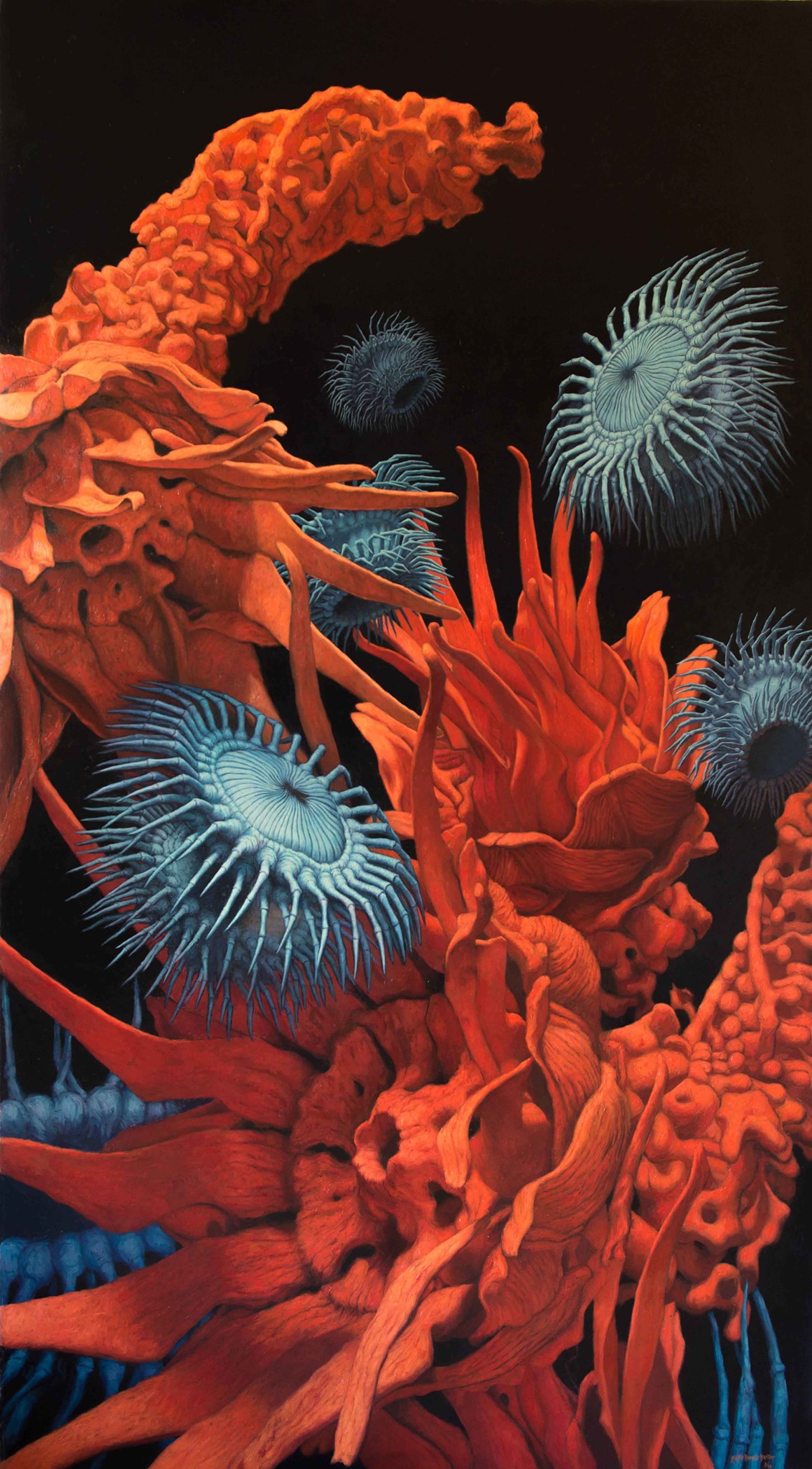
Exploración de límites morfológicos entre reinos, Martin Riveros Baxter, 2018
I’m in Punta del Este, Uruguay, visiting the Ralli Museum—and can’t believe my eyes. Although it is a museum of “Contemporary Latin American Art” it is hugely enjoyable, indeed partecipable. What do I mean by “partecipable”? A busload of elderly people from the US has just arrived, and they are pausing in front of each of the paintings, commenting and, in other words, reacting. When was the last time common folks went to a contemporary art museum that was capable of eliciting a positive reaction from them?
The Ralli Musuem, in Punta del Este, is the first of five; the others are in Santiago del Chile; Marbella, Spain; and two in Cesarea, Israel. All are the brainchild of Harry Recanati, a banker who established a network of private banks in Switzerland, France, and then Uruguay, Peru and Chile. His extensive travels to Latin America allowed him over the years to familiarize himself with the art there, which he found vibrant and lively. Quoting from the Ralli Musuems website: “He was impressed by the quality and the colors and started to acquire works from local artists. Today the Latin American collection of the Recanati Foundation is considered one of the largest in the world.” Sadly, Harry Recanati passed away in 2011, but his legacy lives on in all his museums to which, incidentally, admission is free.
Lobsang Durney, from Valparaiso, Chile, is an immensely talented surreal/post-apocalyptic and yet playful painter who has produced, inter multa alia, a series of paintings called Cheerful Dystopia, which depict iconic landmarks of the western world left in ruins, and yet, somehow, inviting. About the Ralli Musuems he has the following to say: “I really like their curatorial line, which privileges figurative and imaginative art, with a lot of technical quality and skill.”
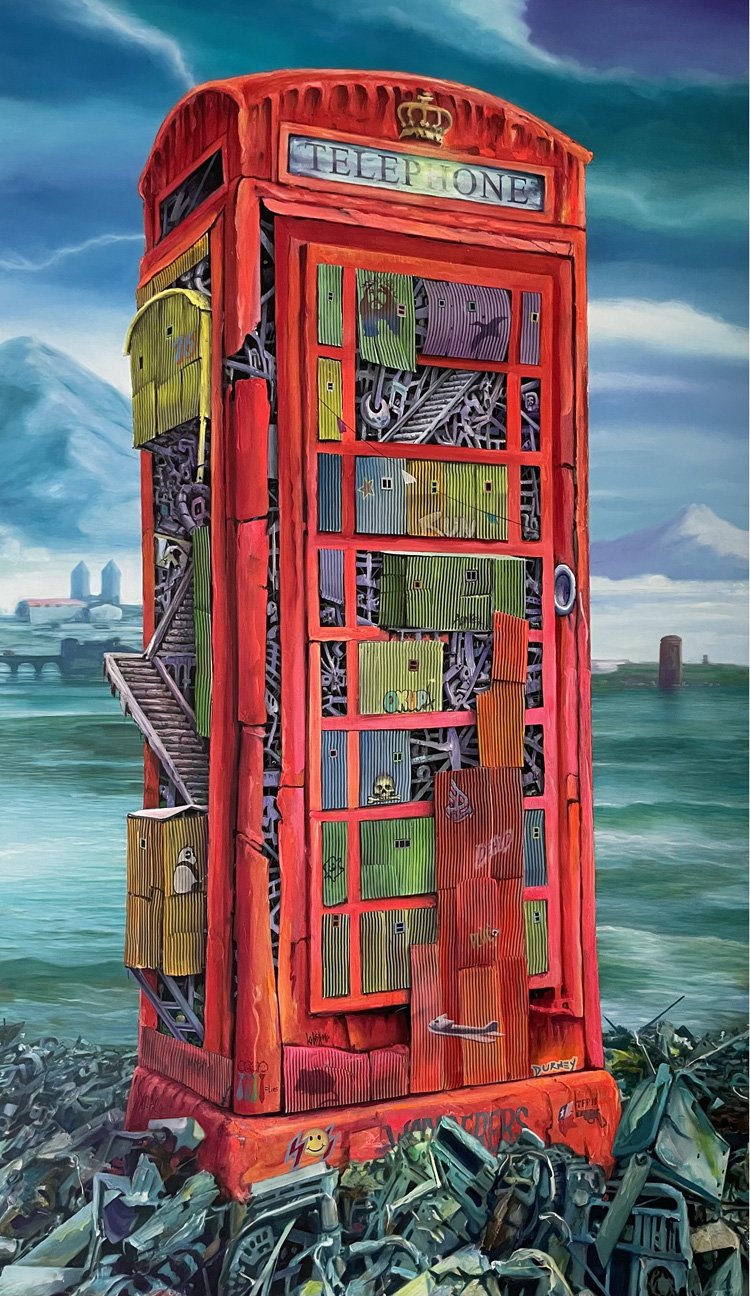
Figurative and imaginative art? Technical quality and skill? That is anathema to the international contemporary art clique, and has been so since the 1950s. The Argentine painter Alejandro Pasquale put it succinctly: “The United States? Forget it, it’s all Pollock there.” Having died in 1956, his stuff should be old hat by now, but it lingers on. Jackson Pollock based his life’s work on a noble quest: trying to reproduce in paint the patterns made by his long-lost father urinating on stone. Such masterpieces, to which I used to refer—perhaps flatteringly?—as “unappetizing spaghetti,” are on display in many major museums the world over.
In order to reach Alejandro Pasquale’s atélier I drove—along a sinuous road weaving through scenery of very distracting beauty—from Bariloche to San Martin de los Andes; there I had to switch to a dirt road; got lost; took another dirt road; and eventually arrived at the destination, followed by clouds of dust. But I wanted to have a chat with him about his art, after having spent a few days in Buenos Aires, and before that in Valparaiso, meeting with several painters there, all extraordinarily talented. I chatted some more with Alejandro. With the US and its art merchants being in control of the international art market, that lingering obsession with those doodles and scribbles they call art, with the gimmicks and artifices, the utter lack of technique, the ongoing imposture—that is what we are fed, and the vast majority of contemporary art museums echo it.

La magia entre nosotros (Magic Among Us), Alejandro Pasquale, 2020
But we the people rebelled against all that a long time ago, all along the 20th century and in the current one too, finding alternative forms of art which the masters of Gimmick and Artifice not only frown upon but completely ignore. In spite of such strictures, Western Art has flourished, from the Taos Society of Artists to Wilson Hurley, Merrill Mahaffey and everyone in between; vintage posters are all the rage; record sleeves were the paintings of the generations who lived for and by music (1950s through the 90s); comics have been and continue to be immensely popular; and in the twenty-first century in particular tattoo art has become widespread, and it too is chiefly figurative. What do Western Art, posters, record sleeves, comics and tattoos have in common? Great draftsmen and painters who were and are possessed of remarkable technique, sometimes prodigious. Because no one should ever lose sight of a simple reality: the Greek word “tékhnē” (τέχνη) means art, technique, or skill. Art without technique and skill is not art.
I went to Villa Alemana, somewhere between Viña del Mar and Santiago but closer to the former, in Chile, to meet Martin Riveros Baxter, a young painter and, for lack of a better word, a genius. As soon as I entered his unremarkable home, I did a double take: what was that, hanging on a wall? Leonardo da Vinci’s The Virgin of the Rocks. I can’t call it a copy, from how perfectly it was executed, and prefer to use the word “tribute.” On a scale 1:1, it could hang at the Louvre and it would take quite some time for people to realize it’s not the original. I asked him why he painted it, and in the most unassuming tone he replied, “For practice.” Immersed in Jungian studies, he told me he was going to start to read Mircea Eliade. I suggested he read Julius Evola’s Meditations on the Peaks, as all that wandering in the unconscious in the long run may become detrimental, while the opposite may now be beneficial—the superconscious. Some of Martin Riveros Baxter’s paintings are so hauntingly beautiful and so supremely accomplished technically, this young man makes me believe in reincarnation.
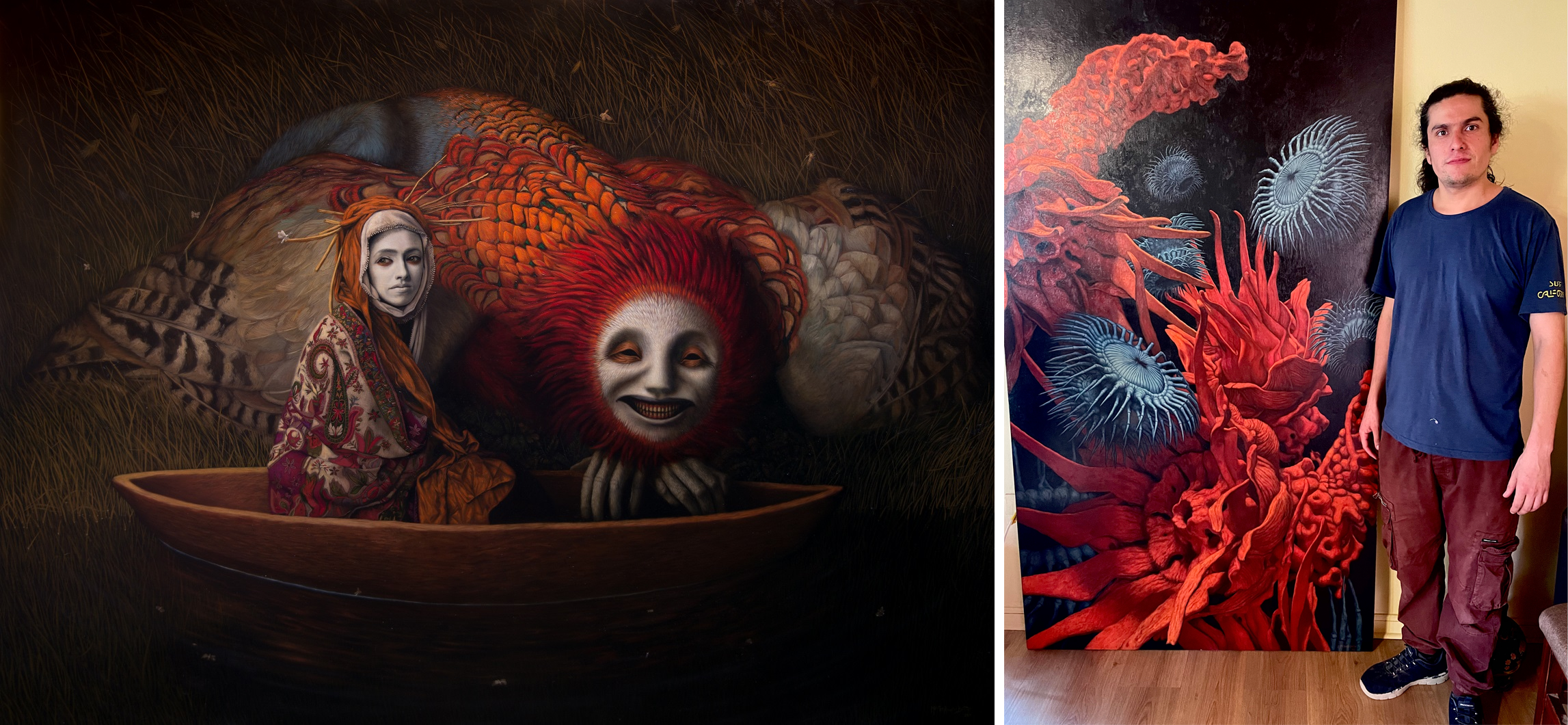
When it comes to temporary exhibitions, the old hat take on art is de rigueur at Buenos Aires’s MALBA, i.e., Museo de Arte Latinoamericano de Buenos Aires—or is it Museum of Antibiotic Latin-American Botched Artificers? When I was in town, at the third floor of this not-too-ugly but none-too-beautiful building (yet the winner of an open call contest: four hundred and fifty proposals from forty-five countries) in the midst of a very handsome city, there was on display the “first panoramic exhibition of Brazilian artist Anna Maria Maiolino”. For the less fortunate among you who know nothing about her, let me hasten to explain that she was born during World War II in a small town in underdeveloped Calabria, Italy, from an Italian father and an Ecuadorian mother; then her family moved to Venezuela and shortly after to Rio de Janeiro; ever since a teenager she was involved in various Brazilian art movements: New Configuration, Neo-Concretism, and the New Brazilian Objectivity. Her paintings were viewed as acts of resistance against the Brazilian military regime, not to mention the Country’s growing inequalities, particularly in its cities. All such qualifications have paid back, and with dividends, for a lifetime:

Ideal for being celebrated around the world as a supreme artist by the purveyors of Gimmick and Artifice. By the way, how is her art? If you are keen on coprophiliac tangles of more or less extended turd-like matter—consistent with her view of “defecation as the ‘first work’”—you will love her opus. How did the visitors at the MALBA like it the day I was there? They would barely peek in to see what was on display on the third floor and immediately spin on their heels and walk out, to go down to the second floor, for the permanent collection. Which, incidentally, could be richer, but still, hats off to Eduardo Costantini, the Argentine businessman who created the museum, though he is not (yet?) in the same league as Harry Recanati (even the brainchild of Patricia Gurdián de Ortiz y Ramiro Ortiz Mayorga, the Museo de Arte Fundación Ortiz-Gurdián in León, Nicaragua, delightfully housed in restored-and-connected colonial buildings, is much richer).
At the Ralli Museum in Punta del Este, on the other hand, people lingered, intrigued in front of the paintings, discussing their content, aesthetics, meaning.
What do we owe conceptual art—or coprophiliac tangles of turd-like matter, in Molino’s take on it—gimmicks, artifice, lack of even the most basic technique, incompetence or, in one word, imposture to? There are many factors. James Stevens Curl has done a remarkable job in explaining what went awry in architecture, both in his masterful book Making Dystopia, and in the essays he pens for NER. Above all, one cannot underestimate the influence on 20th century art of that sublimely injudicious Marxist, Theodor W. Adorno, and his cult of the ugly.
A philosopher and a leading member of the Frankfurt School, as well as a classically trained musician, Adorno argued that subversive tendencies in contemporary art were able to challenge the homogenizing force of capitalism’s culture industry. Herbert Marcuse agreed: himself a founding member of the Frankfurt School, he chimed in on the role of high art in the process of “emancipation” from bourgeois society. Adorno’s Aesthetic Theory explicitly emphasized the importance of the ugly in art. Das Naturschöne (the natural beautiful) along with the artistic beautiful and the sublime, was an essential subject area of aesthetics that had played a significant role in the philosophy of the beautiful since the 18th century. Its opposite was the inherently ugly. The separate thematization of the natural beautiful was based on the fact that not only man-made things, but also natural phenomena could be perceived as appealing and beautiful, thus as natural spectacles. But in Adorno’s view, the lacerating anguish of existence was to be depicted in art, not the pleasing Naturschöne of the loathed bourgeois, whose entire class must be vanquished if the dream of the international Marxist classless society were to be achieved.
Adorno’s cult of the ugly is something like the reverse of Plato’s allegory of the cave. Instead of finding a way out of the cave, where fellow cavemen believe that what is being projected on a wall is reality, and of seeing a far more real and beautiful world, the world of forms, it’s as if we were told to linger in the cave, and never try to find beauty, also because, incidentally, it’s bourgeois.
Cuban artists, who live under the ongoing catastrophe of a Marxist regime, should all be producing stupendously ugly paintings. After all, their Country, ravaged by decades of Communism, is among the poorest in the Americas, and every day any Cuban except party officials must struggle just to find food, let alone brushes and paint. In fact I own several Cuban works of art that were painted on the fabric used by ambulances for their stretchers. Once it becomes too old, instead of throwing it away, it is routinely given to painters for them to use as canvas. Such anguishing poverty should inspire the ugliest art on the planet, right, Herr Adorno? Judge for yourself from the painting The Lamentations of Dike by Cuban painter Yuri Urquiza Shapovalov (in Greek mythology, Dike is the goddess of justice). Cuba deserves a journey of artistic discovery of its own, and sooner or later I will embark on it.
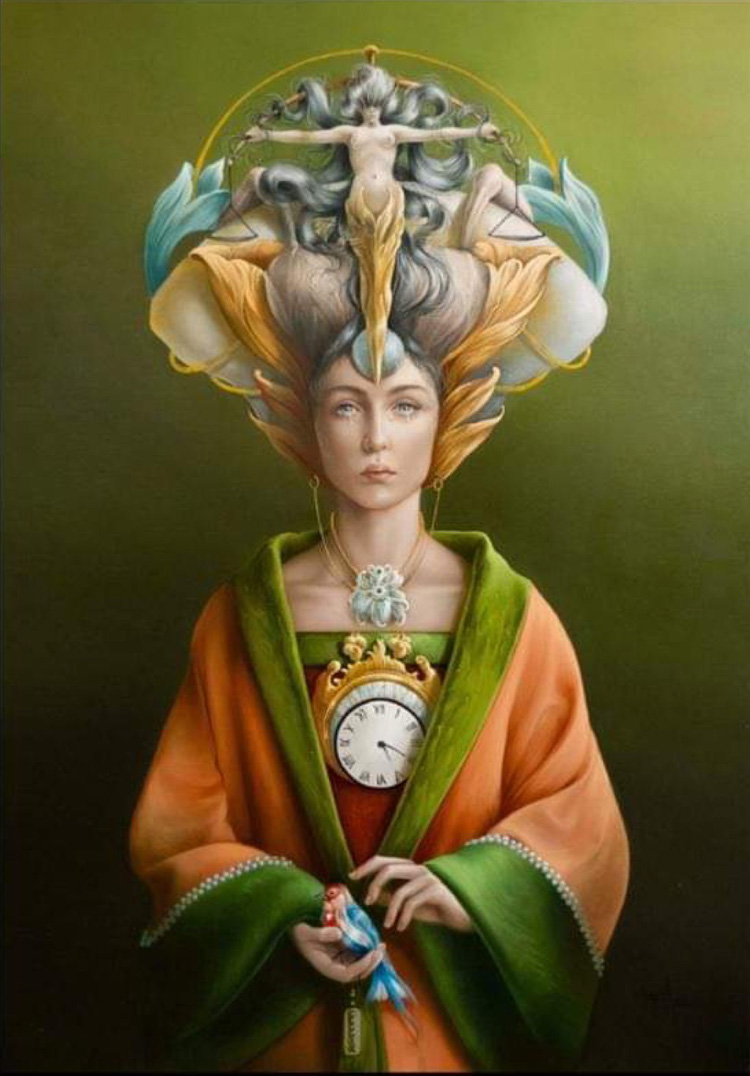
But back to the Cono Sur, or the Southern Cone, the geographic and cultural sub-region composed of Argentina, Chile, and Uruguay. In Punta del Este I had the pleasure to meet with Ignacio Zuloaga in his atélier, which looked more like a jungle, except instead of trees, vines and bromeliads there were large paintings and canvases sprouting everywhere. The vibrant profusion of iridescent and psychedelic colors was extraordinary. Luckily for him and for us, Ignacio Zuloaga is well-established, with paintings of his on display in important museums, and is doing well—though such “important museums” are neither in the US nor in Europe.
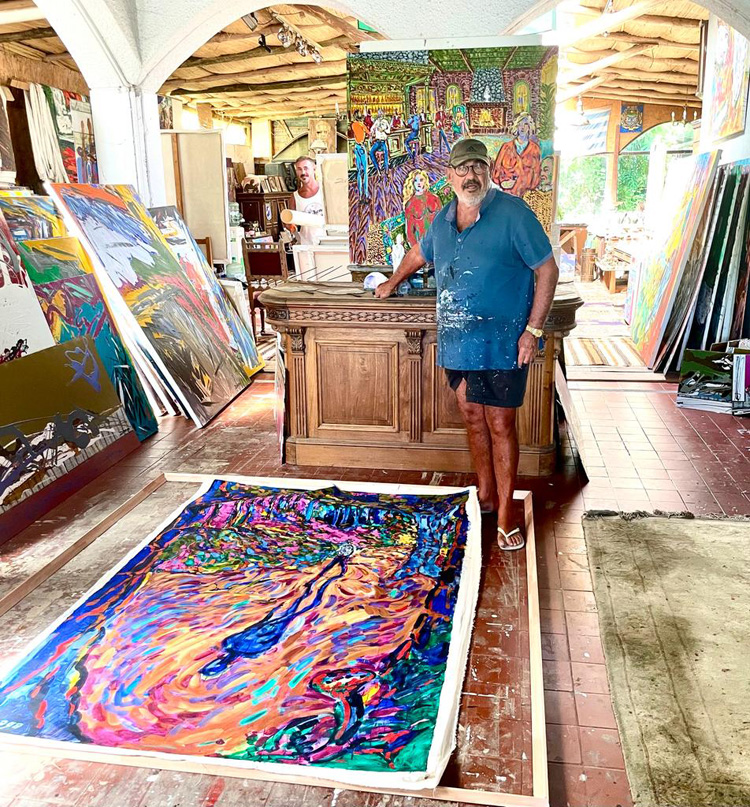
On the other side of Cono Sur, facing the Pacific in that gem of a city that is Valparaiso, Chile, I met with yet more young painters, in addition to the mentioned Martin Riveros Baxter and Lobsang Durney. The latter is lately concerned with time in the Greek meaning of Chronos and Kairos alike, and how to represent them on canvas; the former has just built himself a new atélier from which he will emerge after having painted Heaven knows what strange marvels.
JP Neira has his own take on pop art infused with a sense of humor and supported by a prodigious technique, and knows how to denounce environmental crime without being pedantic, as he realizes that irony and satire will always be better.
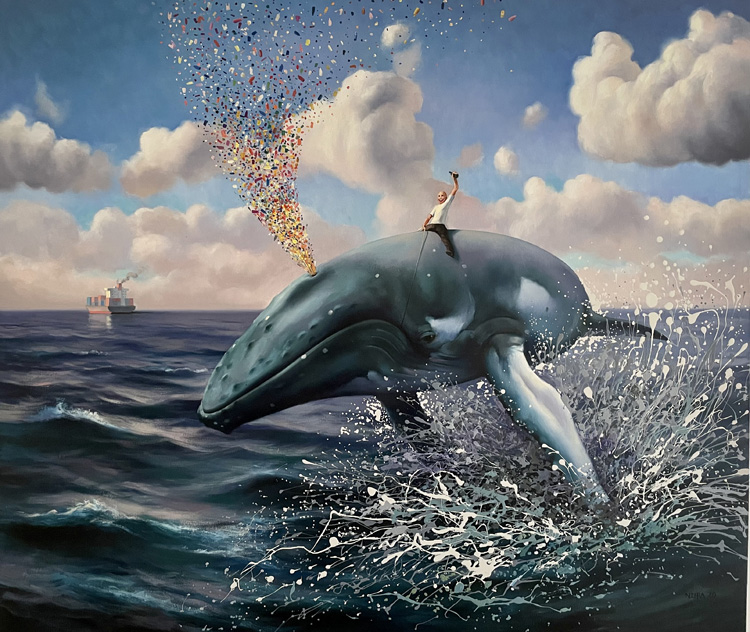
Giancarlo Bertini inserts in almost all of his paintings a miniature Holstein cow seen from above amidst fractured geometrical planes intersected by vibrant colors, in an exquisite mélange.
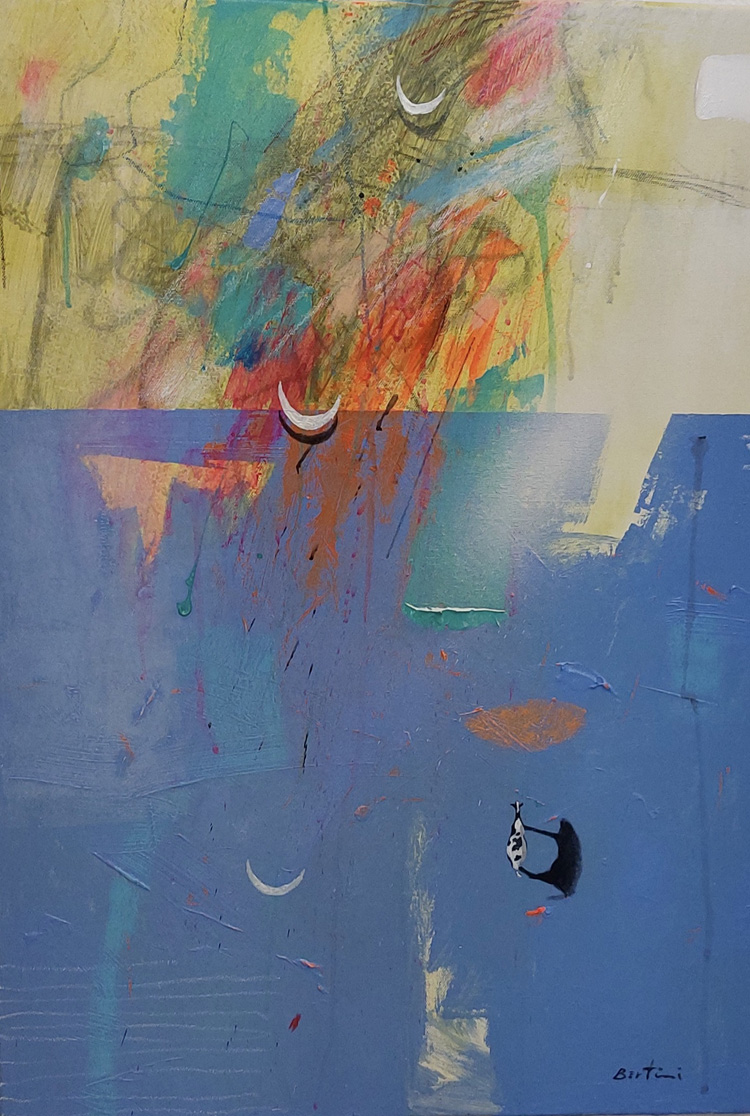
About painting, Álvaro Miranda has the following to say: “To illuminate one must enter the shadows, one must invoke and direct the light, but light can also hide and, instead, the shadow can reveal psychological aspects that words cannot tell us.” And indeed, there is something oneiric and elemental about his art.
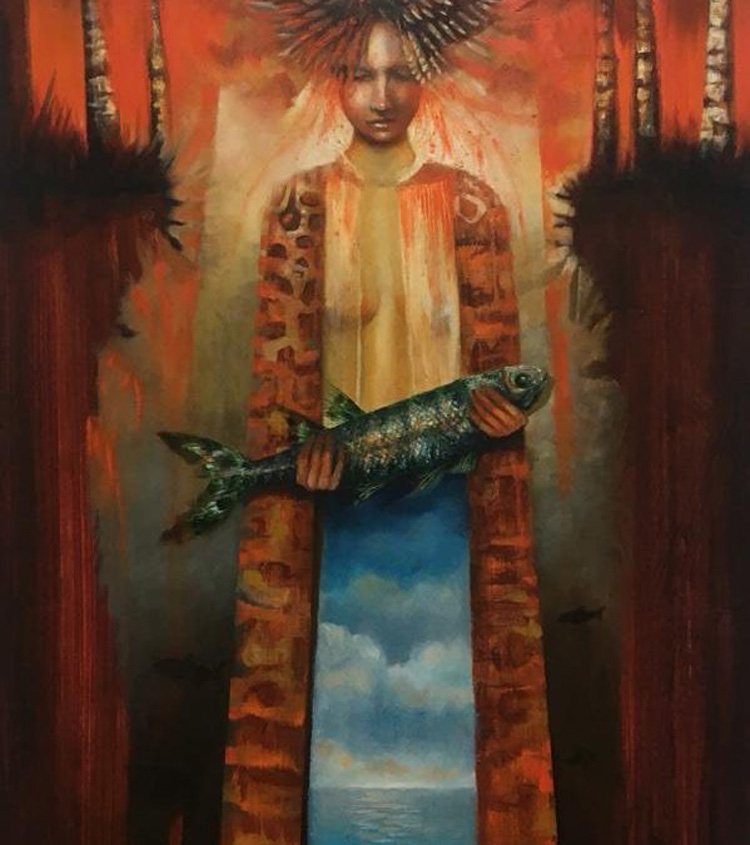
All the supremely accomplished and yet young painters from Valparaiso operate under the umbrella of Bahia Utópica, a contemporary art gallery that has been promoting local talent for the last fifteen years. It reminds me of the Éditions Gallimard of the 1920s (formerly Éditions de la Nouvelle Revue Française [1911–1919] and Librairie Gallimard [1919–1961]), the Parisian publishing house that from its very beginnings did not put a foot wrong and had a most impressive roster of writers, and of Sire Records in the 1970s and 80s, the independent record label that signed most of the major acts from that period.
The art and the artists from the end of the world that Bahia Utópica represents are ready to “invade” the rest of the world. That a relatively small but beautiful and unique city perched over several hills overlooking the Pacific should be the cradle of so many world-class artists is a mystery that cannot be explained away by listing the various local art schools or the profusion of murals everywhere you turn while walking up and down the various cerros. And the art they produce—so imaginative, oneiric, surreal, magical, highly technical and meaningful at the same time—is a breath of fresh air and a new wave of restored sanity and beauty in comparison to the contemporary art(ifice) canon which is imposed upon the western world by the US and by Europe. Unfortunately, I don’t see François Pinault, David Geffen, (the late) Eli Broad and Edythe Broad, buying art from the end of the world, nor do I see Larry Gagosian and Marian Goodman, the eminent gallerists, doing anything about it—those individuals, and not many more, are the gatekeepers. I hope this article contributes to help the artistic new wave from the end of the world to percolate through to the northern hemisphere and find its way where it belongs.
Table of Contents
Guido Mina di Sospiro was born in Buenos Aires, Argentina, into an ancient Italian family. He was raised in Milan, Italy and was educated at the University of Pavia as well as the USC School of Cinema-Television, now known as USC School of Cinematic Arts. He has been living in the United States since the 1980s, currently near Washington, D.C. He is the author of several books including, The Story of Yew, The Forbidden Book, The Metaphysics of Ping Pong, and Forbidden Fruits.
Follow NER on Twitter @NERIconoclast
- Like
- Digg
- Del
- Tumblr
- VKontakte
- Buffer
- Love This
- Odnoklassniki
- Meneame
- Blogger
- Amazon
- Yahoo Mail
- Gmail
- AOL
- Newsvine
- HackerNews
- Evernote
- MySpace
- Mail.ru
- Viadeo
- Line
- Comments
- Yummly
- SMS
- Viber
- Telegram
- Subscribe
- Skype
- Facebook Messenger
- Kakao
- LiveJournal
- Yammer
- Edgar
- Fintel
- Mix
- Instapaper
- Copy Link








